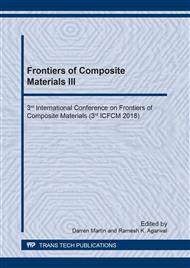p.33
p.39
p.45
p.51
p.57
p.63
p.71
p.77
p.83
Performance of Jute-Glass/Epoxy Composite Curved Laminate under Tensile Loading
Abstract:
In this paper, experimental work on the behavior of composite curved laminate subjected to flexural tensile loading was carried out. Woven roving [∓45] jute, jute-glass, glass-jute and glass/epoxy curved laminates were fabricated by hand lay-up molding. The curved laminate consists of a central circular 90° region connected with two straight arms. Curved laminate length, width and inner radius were 160 mm, 40 mm and 15 mm respectively. Two and four laminate layers were investigated under flexure tensile loading. Test fixture was fabricated to hold the free ends of the curved laminate during the loading process. Effect of stacking sequence, fiber type and number of layers on the tensile load-displacement relation, interlaminar tensile strength (ILTS) and failure mode were investigated. Results show that the maximum tensile load of the glass/epoxy curved laminate is found higher than the glass-jute, jute-glass followed by jute/epoxy curved laminate. Interlaminar tensile strength decreased with the increase in number of layers. The interlaminar tensile strength of glass/ epoxy curved laminate is found higher than the glass-jute, jute-glass followed by jute/epoxy curved laminates. Failure mode is influenced by the material type and number of layers. Increasing the number of layers from two to four leads to interlaminar fracture. Tension and compression fracture were observed respectively on the inner and outer layer of the central region of the curved laminates.
Info:
Periodical:
Pages:
57-61
Citation:
Online since:
April 2019
Authors:
Price:
Сopyright:
© 2019 Trans Tech Publications Ltd. All Rights Reserved
Share:
Citation:


